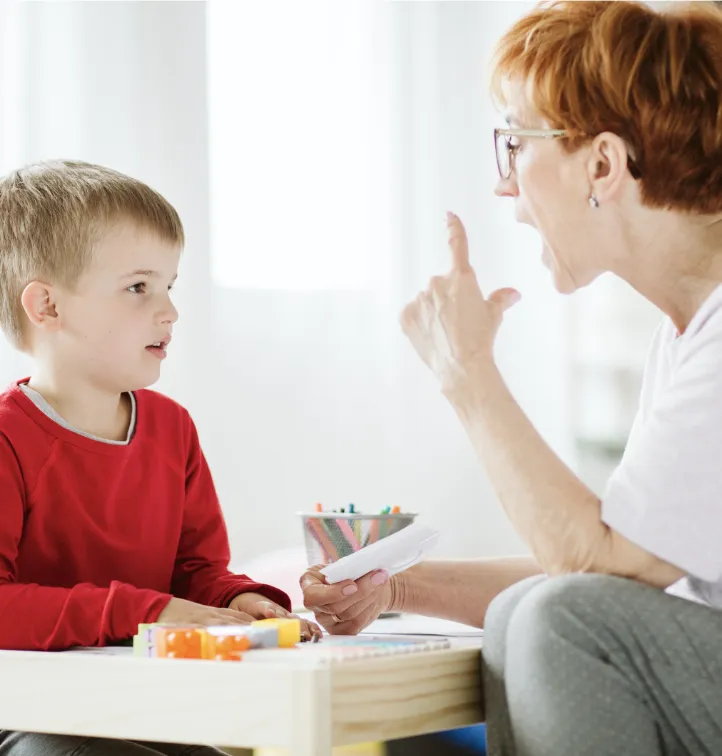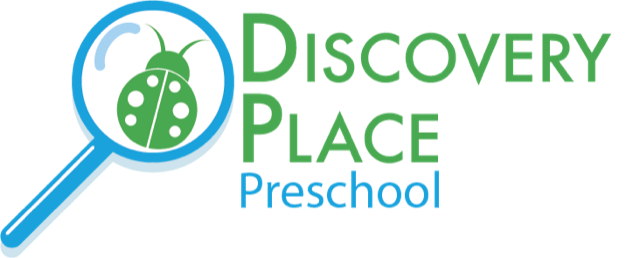Literacy and Phonological Awareness
What is Phonological Awareness?
Phonological awareness is an umbrella term to describe all the smaller skills children develop in their progression toward reading.
Phonological awareness develops in steps from simple skills such as listening to a story to very complex skills such as manipulating individual sounds in words.

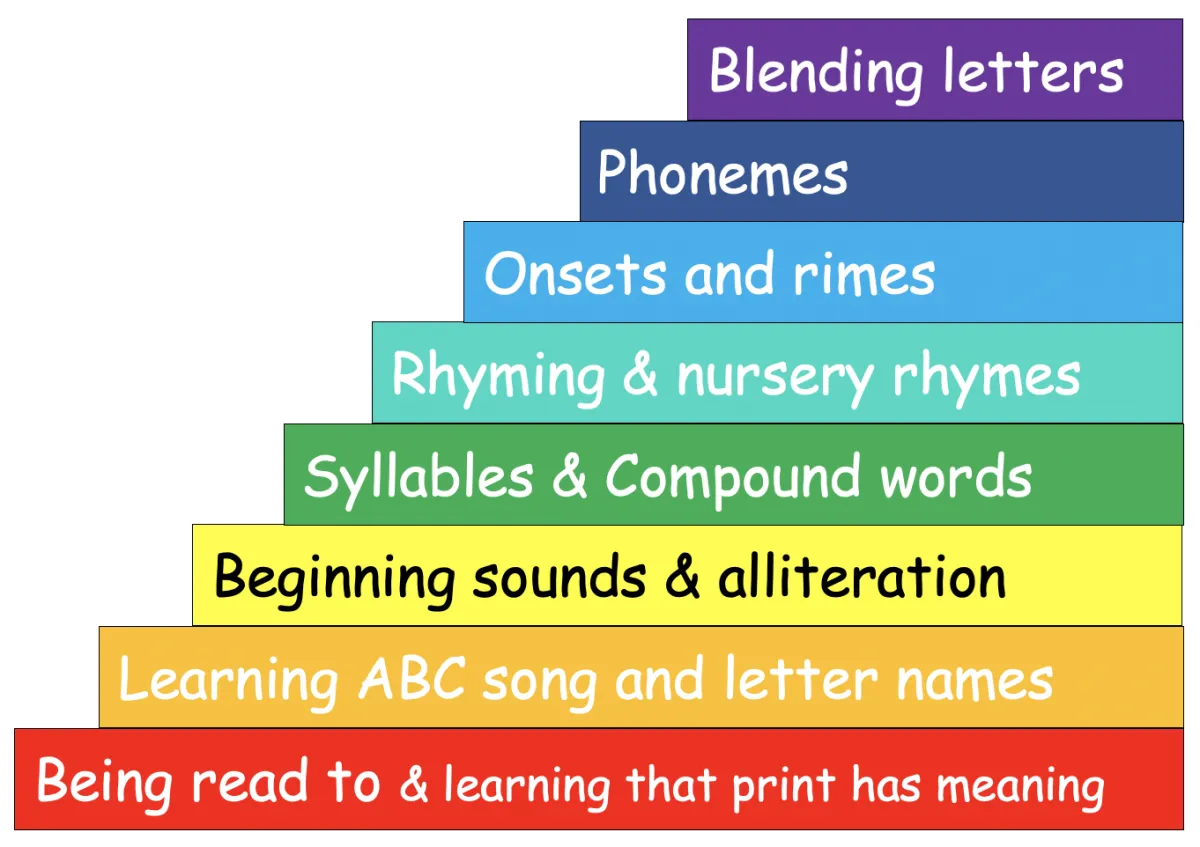
The following activities are fun things you can do at home with your child on the path toward phonological awareness and reading!
Infant and Toddler Years
The Best Start is
Talking and Interacting with your Infant
It takes four things for interactions to build your child's brain:
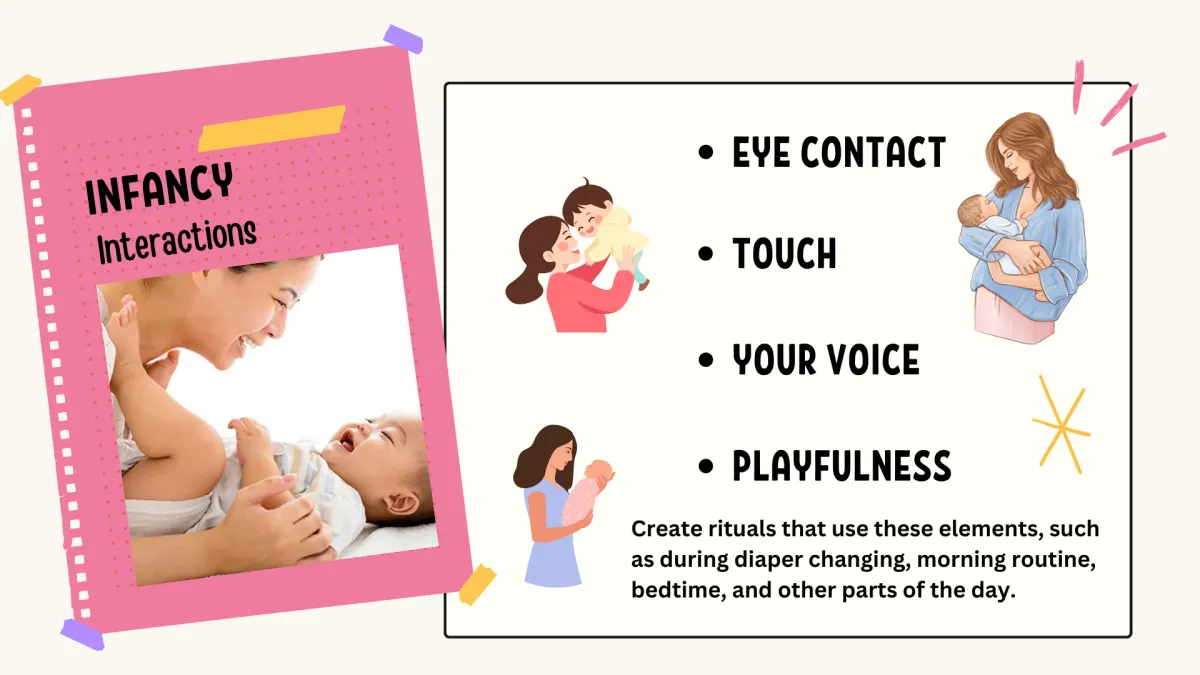
Below is an example:
Research shows that these four elements helps integrate the right and left brain hemispheres in preparation for reading.
Being Read to Daily Helps...
Build a great relationship that will be important for later learning. Be sure to begin an early habit of reading to your child daily.
Develop trust for learning. Children first learn that you love and care about them. This develops into trusting you. A child needs to trust you to learn from you. Without trust, teaching your child will be a struggle.
Develop listening skills. Listening skills are necessary for learning to later discriminate individual sounds in words. You can also help your child learn listening skills by playing some recorded sounds of objects and see if they can identify what the sound is. You can learn about birds and various bird calls and then learn to identify specific bird calls in nature. This will help them later listen for individual sounds in words.
Build knowledge that words have meaning. If you occasionally point to the words in the story, they will learn that words represent information.
Build vocabulary and knowledge about the world. This will be important for school when kids begin reading. If they don't have a good vocabulary, it may interfere with word recognition and background knowledge for things they will be learning. They need to know basic information about the world in order to connect concepts they learn in school.
Learn that print goes from left to right. As you read, they will begin to see the patterns of reading and the right direction to turn pages in a book. It all goes from left to right.
Build brain connections. Neuronal connections get formed as your child sits on your lap, hears your voice, and enjoys a close relationship. This helps integrate the right and left brain hemispheres in preparation for reading.
Learn that knowledge comes from books. They will begin to see that books are a source of knowledge. Read both fiction and non-fiction books. Check out books from the library on a regular basis. When your child has a question, you can say "next time we go to the library, we can check out a book on that topic."
Preschool Years
Two Different Views on Teaching the Alphabet
View 1. Don't teach it until School
Children need to play and be a kid.
Teaching alphabet early interferes with play
Teaching it early can turn your child off to learning altogether

View 2. Teach it as early as possible
Teaching alphabet early can help you see if your child has learning difficulties.
It can help you learn your child's learning style
You don't want your child to be behind in school

Combine the Best of Both Views
Teach alphabet during the preschool years, yet do it in a play-based way to make it fun and meaningful.
Don't force it or you will turn your child off to learning. Go at your child's pace.
Teaching the alphabet early can help you learn sooner if your child has dyslexia or another learning disability and get needed supports in place.
It helps you learn your child's learning style early and align your help to best meet their needs
Early exposure in a play-based and meaningful way helps set your child's brain for school success
Play based learning gets kids excited for school and not turned off to school
Entering Kindergarten with alphabet knowledge helps them feel good about their skills and not feel behind their peers.
Below are Ideas for Teaching Literacy in a Play-Based Way
Begin with what your child already knows
Children are sound experts. They were born and pre-wired to tune into sounds in language.
Learning the alphabet and reading are not pre-wired and do need to be taught.
Take a sound-first approach to teaching the alphabet since your child already knows sounds.
See the examples below for ways to explain this.

"When you see something scary, you say 'Aaaa,' The sound you are making can be represented by this letter: A"

"When you go to the doctor, and she asks you to open your mouth wide and say 'Ahh', that sound can be represented by this symbol: O."

"When you have been running around and playing hard, you make a sound that can be represented by this letter: H."
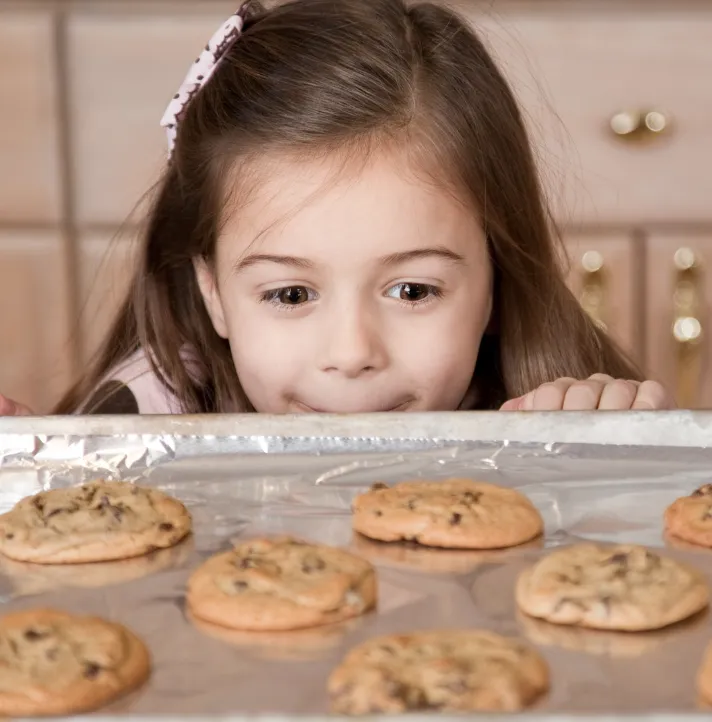
"When you see something yummy, you sometimes make this sound 'mmmm' and it is represented with this letter: M"
Point out these sounds when it is meaningful to your child.
When you happen to hear your child breathing heavily after playing hard, say, "You are making the sound that letter H makes."
When your child says "Mmmmm" after eating something yummy, say, "The sound you are making looks like this (and point to a letter M.).
When you hiss like a snake with the "ssss" sound, point out that the sound a snake makes is letter S, and a snake can be shaped like a letter S.
When a package comes that has packing material you can pop, have your child pop one and say, "The sound it makes kind of sounds like "p" and that sound is represented like this: P
Learning the ABC Song
and Letter Names
You can sing the ABC song while running errands in the car, while fixing
dinner, or at other moments you are with your child. Eventually your child will join in with you as you sing it together.As you have been pointing out sounds and showing your child the symbols they represent, you can begin pointing out the letters in your child's name and in other family members' and friends' names. Or you can point to D for dinosaur if your child is interested in dinosaurs. Make it meaningful to your child based on what is important to them.
Once your child knows several alphabet letters, you can use a simple ABC chart and sing the ABC song while pointing to each letter as you sing, including pointing individually to L, M, N, O, and P.
Once your child can sing the ABC song and point to the letters as he sings their names on the alphabet chart, he can find out himself any letters he does not know. If he sees a letter somewhere in the environment and
does not know what that letter is, he can go to the chart and sing as he points until he gets to the unfamiliar letter. Singing it will reveal its name. If your child needs an alphabet chart, click on the image of the chart and you can download a copy of it.Follow your child's lead and back off at moments when your child is not interested. It really is not a requirement that parents teach the alphabet. Don't put pressure on yourself to meet a certain deadline or this may turn your child off to learning.
Click on the alphabet chart above to download a copy
Beginning Sounds
The first decoding step in learning to read is learning to isolate the beginning sounds in words. This can be taught the same way as with singing the ABC song and then pointing to each letter. Alphabet charts typically have a picture of something that starts with that letter. Show your child how that works. Point out that each letter has a picture of a word that starts with that alphabet letter's sound.
Point to A for apple and say 'a'pple. A says 'a'. Then your child can do the same for the rest of the letters. There are many more play-based activities you can do to help your child learn beginning sounds. Below are some examples of activities you can play to learn beginning sounds.
Same Sound Sort. Around age 3 and 4 you can gather objects from your house that begin with either "b" or "m", for example, or any two letters that have very different sounds. Then have your child sort them into piles with all the objects that begin with the "b" sound and those that begin with the "m" sound. To the right is a link to a free activity like this that you can download from Teachers Pay Teachers with the letters B and H.
Read Silly Alphabet Books that have lots of words for each alphabet letter. One fun one is Dr. Suess's ABC book. Emphasize the alphabet sounds for each letter.
Focus on just one letter and go around the house finding objects that start with that letter. You could also note all during the day when you notice a word that starts with that letter. See if your child joins in. All you need to do is casually notice to yourself out loud when a word starts with that letter. It doesn't need to be dramatic. Your child might even join in but say a word that does not begin with that sound. That's ok. He is just learning, but he is joining in the game, which is a good sign that he wants to learn.
Alliteration is another activity to try. Alliteration is naming several words that start with the same first letter. An example is "Peter Piper picked a peck of pickled peppers." You can also just merely point out when a sentence you say happened to have 2 or more words that started with the same sound. For example, "On Monday we are having muffins and milk." Then be surprised and say, "Oh, Monday, muffins, and milk all start with M!"

You can download this free resource from Teachers Pay Teachers (TPT) at
A note about beginning sounds
It is important with letter sounds that you not focus for too long on just learning the beginning sounds. Children often go to preschool learning "letter of the week" for a year or even two without really making the connection between beginning sounds and real words. Marnie Ginsberg with Reading Simplified promotes building real words once your child knows about 10 to 15 letter sounds, including 2-3 vowels. Then they are ready to begin forming words. The reason for this is that if kids get stuck just learning letter sounds for too many months or even years, they run the risk of not being motivated to continue since the memorizing of sounds is isolated from the reason they are doing it in the first place. The reason is to learn how to read. If they are only learning sounds without putting that knowledge into meaningful practice, they don't retain the knowledge as well. Using the science of reading, Marnie Ginsberg promotes a game called "Build-it" once your child knows 10-15 letter sounds and 2-3 vowels. See the example below.
How to Play "Build-it"
Once your child knows about 10-15 letter sounds (including 2-3 vowel sounds), they are ready to begin forming words. See the example in the following video of a 4-year-old child building a simple word after just learning a few sounds. Being able to distinguish the middle and ending sounds in words is just as important as learning the beginning sounds in words.
More on Learning & Writing ABCs
To learn the alphabet, it is important to allow your child to write it. The reason is that kids learn by doing, and writing provides the "doing" part. It also helps get the information into their brain since "hands-on" learning works best. Here are more pointers:
Use short golf pencils so your child learns how to hold the pencil correctly. It is harder to hold it with a fist if the pencil is small.
Teach correct letter formation during the preschool years because in Kindergarten, the teacher has 20 or more students and cannot help them one-on-one as easily as a parent can.
Teach the letters in your child's name first. Then move on to family members or other things that interest them.
How to write letters
I love the alphabet page from Mrs. Galvan on Teachers Pay Teachers (TPT).
To do a Google search for it, type in "TPT Alphabet page and handwriting cards FREE Mrs Galvan." It helps your child identify the uppercase and lowercase letters, know the letter sound, and it also helps your child know how to write it too. This video shows how to write each letter using this chart.

Compound Words
Before children can learn to decode words for reading, they need to learn how to break them down into their individual sounds. You can help children learn how to do this by introducing compound words such as 'sand' and 'box' make 'sandbox'. This is a very simple way of listening to parts of words.
To introduce it, you can tell the story of the man named Mr. Forgetful. There was a man named Mr. Forgetful who always forgot to say the ending of words. For example, if he wanted to say, "football", he would say, "foot." If he wanted to say, "basketball," he would say, "basket." Then you can wonder out loud, "I wonder what he would say for 'ladybug'. See if your child can say any part of the beginning such as 'lady' or even 'lay'. This activity helps them learn how to isolate sounds in words so they can say just the beginning part. This is an important skill in phonological awareness.
Syllables
Teaching syllables is fun if you make it meaningful to the child. A good way to begin is learn to tap to the beat of music. Just tap, clap, or tap your foot to the beat of various songs. Use drums or other percussion instruments to tap the rhythm.
Then introduce to your child that people's names have beats too. Clap your child's name and say, "Your name has two beats: Sar-ah". Then wonder out loud "I wonder how many beats Daddy's name has." Then clap his name, then your child's brothers and sisters and cousins, aunts, uncles, friends, grandparents, pets, etc. Then wonder if objects have beats too and be surprised that they do!
Tap the beats in objects around the house. If your child is still interested, you can write on paper a column labeled 1 beat, another labeled 2 beats, and a third with 3 beats. Make a tally mark under each column that you discover a word or a person's name that has that many beats. This can happen over the course of a day, a week, a month, etc. Then see which column has the most. This is teaching science and math skills as well as literacy skills.

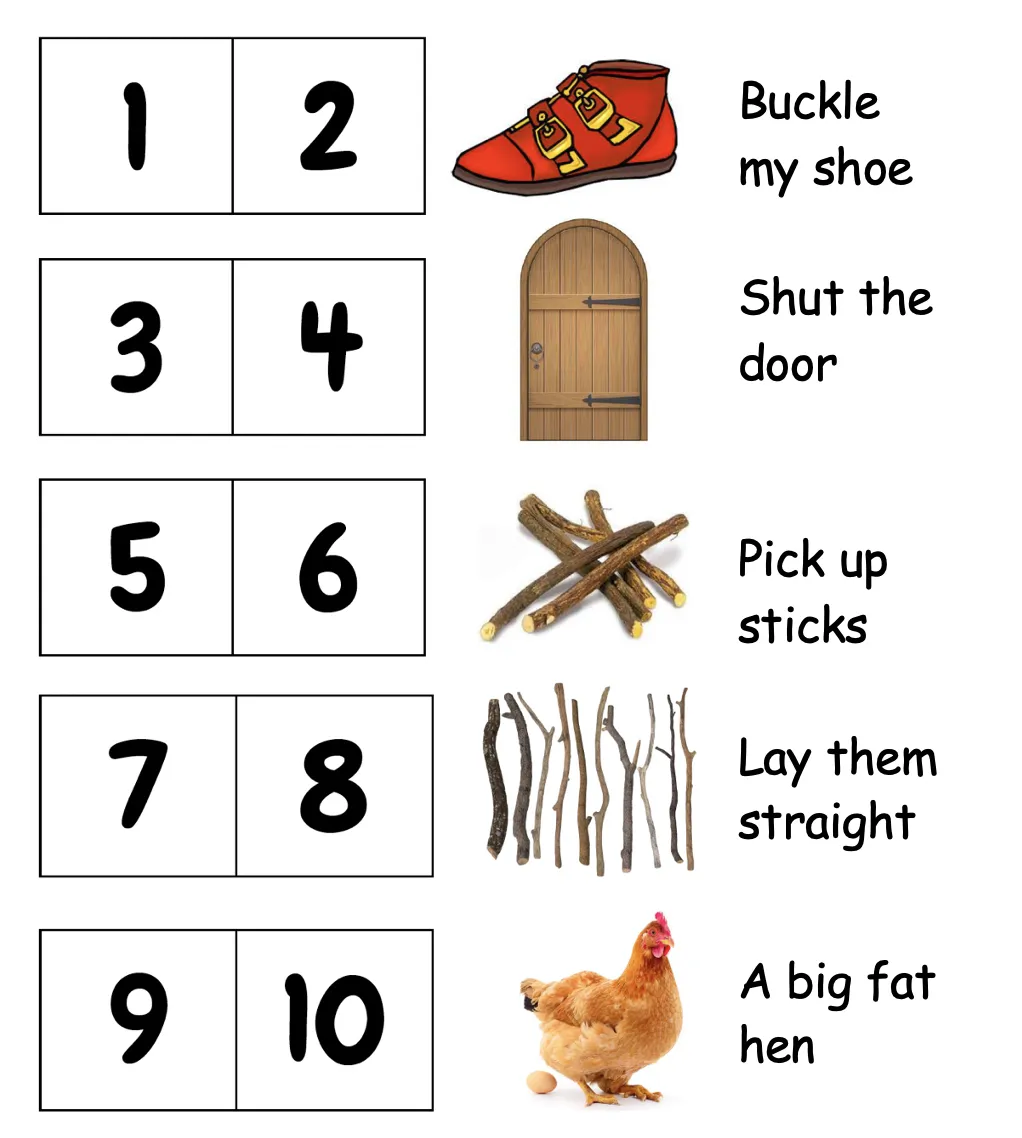
This resource can be purchased from Tiny Books on Teachers Pay Teachers (TPT) at https://www.teacherspayteachers.com/Product/Emergent-1-2-Buckle-My-Shoe-5937917
Rhyming Words
Understanding rhyming takes a bit longer for children to grasp than compound words and syllables. When they learn beginning sounds, it is hard at first to transition to listening to ending sounds because they were accustomed to listening to the beginning sound of the words. Below are some steps you can take in your child's progression toward learning rhyming.
Read simple rhyming stories and nursery rhymes. As you read them, keep a subtle steady beat so your child feels the rhythm of rhyming. Then after you have read several rhyming stories over the course of several days, you can re-read one of your child's favorite rhyming stories. Then after you have read, for example, "One, two, buckle my shoe, three, four, shut the _________" you might pause when the rhyming word comes up and see if your child fills it in. You can also use a visual such as the one on the left so your child can "read' the poem with the numbers and pictures. At first, your child will fill in the blank because he remembers you reading the story, but this is still a step in the progression of learning to rhyme.
Read a rhyming story your child has not heard before and pause when you come to one of the rhyming words to see if your child can fill in the blank based on their knowledge of something that makes sense. If they have figured out rhyming, they will be able to do this. It's ok if they don't. Rhyming takes time.
CV rhymes. C stands for consonant and V stands for vowel. Just use rhyming words that have one consonant sound and one vowel sound. For example, say "Bee, me" or "Hi, my". Or name a bunch of words and see if your child can add one more, "Be, me, see, he, tea, knee" or moving on to CVCC words, you can say "wall tall, fall, mall, ball."
"Could you pass the cheese please." As you go about your day, if you happen to say something that rhymes, such as "Could you pass the cheese, please?" say, "Oh, that rhymed: cheese, please" so your child notices it along with you. Mention something practically every day for a period of time so your child gets exposed to rhyming. Don't overdo it to the point your child gets annoyed, though.
Consonant blend rhymes. After your child can do CV rhymes, such as add one more to "hi, my, bye, sigh, tie", you can add consonant blends such as "Play and sway". Those begin with consonant blends. You don't need to tell your child this, but be aware yourself that these words are consonant blends and they are harder to notice in rhymes than they are in CV rhymes. Don't drill these or quiz your child on them or they might back away. Just mention rhyming words and notice that they rhyme. Getting exposure is what's important.
Rhyming games. If your child wants to play a game with rhyming words, you can do thumbs up to indicate a pair of words rhyme and thumbs down to indicate they don't rhyme. This is easier to for children to do than to come up with rhyming words on their own. For example, say, "bee tree" and your child will do a thumbs up. Or, say, "dog bird" and your child will make a thumbs down. Then your child can have a turn to say some words and you can put your thumb up or down. This way you can see if he knows how to come up with rhyming words on his own.
Avoid rhyming with numbers. One caution is don't use numbers in rhyming in the beginning. This totally confuses kids. For example, don't say, "Name a word that rhymes with Two." or your child might say "three?" or they might point to a set of two objects. It is too confusing for your child if you throw numbers in.
Write poems together. Start by having your child come up with a topic to write about. As you write lines of the poem together, you can pause where the next line should have a rhyming word and say, "now we need to find a word that rhymes with [name the last word of that line]. For example, on Father's Day, write a poem about your child's dad that says something simple like, "My dad is rad. He is not bad. He never gets mad." or something simple like that.
Kindergarten & School Years
The line between Preschool and Kindergarten is a bit fuzzy. Some preschool kids are ready for Kindergarten concepts, and some Kindergarteners might not have mastered all the preschool concepts. Kindergarten teachers will review many of the preschool concepts in the first couple of months of school, so the placement of this heading of "Kindergarten and School Years" could move up or down based on each child's abilities.
Onsets and Rimes
This is a fun one. Don't confuse "rimes" with "rhymes". They are similar, but not the same. Onsets and rimes go together. Onset is the beginning sound and rime is the ending of the words. This is often referred to as "word families." An example of a rime is "at". All you do is add onsets (different beginning sounds) to the rime so you have all the words that go in that word family, "bat, cat, fat, sat, mat," etc. Another word family rime is "ab" as in "cab, tab, dab, gab", etc. There are many word families.

Image from Lakeshorelearning.com

This is available at www.EducationToTheCore.com
Phonemes
Phonemes are individual sounds in words. This is not to be confused with individual letters--just sounds. For example, the word 'night' has three phonemes: 'n', 'i' and 't'. Learning phonemes is something your preschooler might understand closer to age five. You can say, "How many sounds are in your name, 'Josh'. 'j', 'o', and 'sh'. Three sounds."
You can then explore other family members names like you did with syllables, 'm' 'o' 'm' and 'd', 'a', 'd'. Begin it just as a listening skill. Later when your child is in Kindergarten, you can do it as a writing skill.
The image on the left is an example of writing the individual letters in the boxes for the number of sounds your child hears. The example has one letter for each sound, but some sounds have two or more letters for one sound, such as "shell." 'Sh' is one sound, 'e' is the next sound, and 'll' is the last sound. Your child would just write 'sh' in one box and 'e' in the next box and 'll' in the third box. You can use small gems or other marker for the three boxes in the "map it' section. Then use alphabet letters for the 'graph it' section. For the top section, your child says the word and counts the syllables. Below are more ways to help your child learn how to isolate individual sounds in words.
Play a game where you say things like, "say 'pig.' Now instead of saying the 'p' sound, say 'j'. See if your child makes the word 'jig.' Children might not be able to do this mentally until age 5 or 6. Before then, you can show the words visually with alphabet letters and switch out one letter at a time to form a new word.
An even more difficult exercise for older ages would be to do this with consonant blends. For example, say, "Say the word 'play.' Now say it without the 'l' sound. The new is 'pay.'
Blending letters
When your child begins blending letters, is an exciting time because your child can feel like he is actually reading, which he really is! Begin with CV or CVC words, which means C for consonant and V for vowel. These are simple two or three letter words with a vowel in the middle. An example of a CV word is "me," and an example of a CVC word is "pig." There are several fun ways to do this. Go back and review, in the preschool section, the video of the game called "Build it." Once your child can do build-it fairly easily, or is getting it right 70% of the time, move on to the "Switch-it" game below.
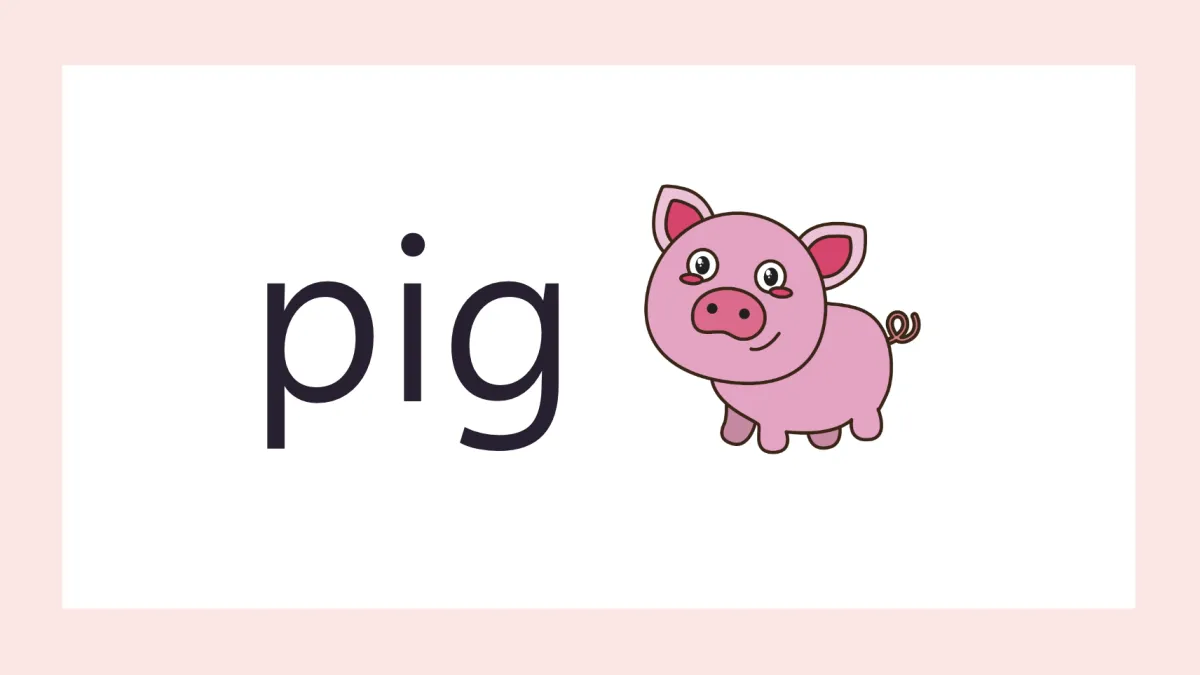

To read more about this visit: http://www.sl3lab.com/new-blog/2016/11/23/more-than-letter-reversals-dyslexia-described-plain-and-simple
A comment about sight words
It is best in the beginning to focus mostly on phonics and sounding out words, and less focus on memorizing sight words. The reasons are:
Sight word memorization activates the right brain
Struggling readers show more signs of right side activity of the brain when reading
Proficient good readers activate mostly the left brain when reading
Phonemic awareness and phonics skills (sounding out words and listening for sounds in words) activate the left brain.
Infants use mostly the right side of the brain, but this shifts during the ages of 5-7 to mainly using the left side of the brain. This shift is important for future learning.
If kids get too used to memorizing words by sight or shape, they can do not make the necessary shift from right brain to left brain activation for reading.
In about 3rd and 4th grade, readers who have focused on memorizing words instead of sounding them out begin to struggle. They no longer have picture cues and phonics knowledge has not been exercised as much, so it gets lost.
Research shows that if kids are not reading proficiently by 4th grade, 2/3rds of them will end up in prison or in poverty.
Phonics/decoding skills can be more challenging in the beginning, but it pays off in the end. Focusing on sounding out words, rather than memorizing them produces a better left brain and better reading.
Switch-it Game
Games like "Switch it" activate the left side of the brain. For the switch-it game, you begin with a set of letter sounds, and your child switches out just one letter each time to form a new word. See the video for a demonstration of the "Switch-it" game. In this example, the first two words are demonstrated, but the words could continue one letter at a time for the words milk, silk, silt, sift, lift, left, lent, went, wet, pet, pets, and pest. This activity helps to work the left side of the brain which is important for fluent reading.

This image shows a picture created by a child in my preschool who noticed the stuffed animal turtle was missing, so she wrote this sign and posted it on the wall, It says, "Missing Turtle." She drew a picture of it so the other children in the preschool could know what it looked like and find it. The M at the beginning is upside down.
Writing using Inventive Spelling
Have your child write their own messages using the concepts they already know about sounds in words. If they understand that words carry meaning and if they have watched people in their world write messages and notes, they can begin doing this too. They can write their own story or just write a message along with a picture they draw.
They can pretend they are at work and write what they are doing. If you set up a play area for a pretend vet clinic, they can take care of pretend pets and write notes about what the owner needs to do to care for that pet, such as they may write, "2 plz" meaning that the owner needs to give their dog 2 pills every day. Children usually have a harder time hearing the vowels in words, so they usually use the consonants in the beginning. Inventive spelling can lead into regular spelling. Don't worry that they will learn incorrect spellings. They are learning that the sounds blend together to form words.
Practice with middle sounds and ending sounds
After your child had beginning sounds down, she can focus on middle or ending sounds. Ending sounds are easier if you focus on consonants. Vowels are harder to hear, particularly if they are in the middle of a word. For ending sounds, show an image of a CVC word with the final letter missing in the word and show 3 options of letters to choose from. Your child can use a clothes pin or a paper clip to clip to the correct letter sound. This same thing can be done with beginning sounds or middle sounds.

This image comes from a free resource from Kindergarten Worksheets and Games at

Digraphs
A digraph is two letters that make one sound. Some of the simplest ones to learn first are ch, sh, th, and wh. One fun way to learn 'ch' is to cut food labels from boxes and packages like Chex cereal, Cheerios, and a package of cheese. Point out when you see 'ch' in environmental print that is meaningful to your child. With the food labels, you can create a recipe for your child to make their own snack using those labels and the food items in bowls. The recipe can say, 1 scoop [Chex label], 1 scoop [Cheerios label], and one [cheese stick label].
Fun Literacy Ideas for Any Age
Acting out Stories
Acting out stories helps with comprehension and provides a fun way to engage with others and have fun. In my preschool last year, we did a Literature Study and read and compared books and acted them out. We began with reading The Rough-Faced Girl and Cinderella. We acted out both stores, and then we filled out the chart on the right to see what was the same and what was different about the two stories. The kids came up with great ideas after having read them and acted them out, they could see the comparisons much more easily. We also drew pictures of characters in the stories. Below shows the cover of the book, "The Rough-Faced Girl" and then paintings the kids made of the Rough-Faced Girl.

This diagram template came from Amy Lemons from Teachers Pay Teachers (TPT).




Acting out Various Versions of Stories
There are a LOT of cute versions of the Three Little Pigs. To the left is an example of reading two stories: "The Three Little Pigs" and then "The Three Little Wolves and the Big Bad Pig." There is also "The True Story of the Three Little Pigs" and more.

Signs of Dyslexia and Other Reading Difficulties
Signs of Dyslexia in Preschoolers
Has trouble learning simple nursery rhymes, such as 1, 2 buckle my shoe (scroll up to see this visual) or even song lyrics that rhyme
Has memory recall problems when trying to name a common object. May resort to saying "thing" or "stuff" instead.
May struggle to memorize lists of items that go in order, such as learning the ABC song
Delayed language development and has fewer overall vocabulary words
Has letter reversals in language such as says "aminal" instead of "animal" or "beddy tare" instead of "teddy bear"
At preschool they may not speak a s much as other kids
Trouble creating a rhyme or difficulty hearing that two words rhyme
Difficulty following directions with multiple steps due to information processing difficulties, may only process parts of the instructions that are given
Struggles talking about an event in a logical order
Next Steps for Preschoolers
This information came from www.Understood.org.
If you suspect your child has dyslexia, you can discuss it with your child's doctor or school, or if you child has an IEP, you can bring it up in a meeting with the school or program your child is in. It does not mean your child will not learn to read; it only means there is a reason behind the struggle to learn nursery rhymes, recall information, and struggles to recall words. .Working the left brain more will help your child catch up with their peers. Do the activities listed earlier that use eye contact, touch, your voice, and playfulness. Your child might need a little more support than other children learning the ABC song, alphabet letters and sounds, and other literacy skills, but dyslexic children can learn to read with consistent practice building the left brain. Dyslexic children have more right brain activity than other children, so doing these exercises will help get more brain activity on the left side.
View my workshop on Literacy and the research that works best for dyslexic kids.
Signs of Dyslexia in Elementary School
Has trouble with spelling, may spell the same word correctly and incorrectly in the same writing assignment
Has trouble sounding out words
Often confuses letters that look similar such as d and b, p and q
Confuses letters that sound similar such as d and t, b and p, f and v
Often doesn’t recognize common sight words
Reads slowly
Struggles to find the right word to say, may say "um" a lot or other words as fillers
May struggle with words that are similar such as saying 'internal' instead of 'eternal' or 'extinct' instead of 'instinct'
In 3rd through 5th grade, may skip words in sentences such as 'in' or 'the' without noticing them
Struggling to remember what happened in a story they read
This information came from www.Understood.org.
Next Steps for Elementary School Kids
You can talk with your child's teacher and also the school counselor to see if your child can get tested for learning challenges and get an IEP. Schools do not diagnose; they only offer supports for kids who struggle. Even though sounding out words is a struggle, the more this is practiced, just like anything, the better you get at it. Research has found that focusing on phonics and sounding out words with dyslexics helps them much more in the long run than if you focus on memorizing sight words. Learning phonics exercises the left brain, and memorizing sight words exercises the right brain. Dyslexics need their left brain exercised to catch up with their peers. Work on phonics exercises that are game-line and play-based rather than drilling. Use some of the play-based strategies on this site is important for dyslexics to get this practice since it exercises the left brain. Sometimes when kids read out loud at school, they become self conscious about their reading, and this furthers the cycle of reading less. Do all you can to encourage your dyslexic child to persist. Getting better at reading will help their confidence at school and get them excited to read more.
View my workshop on Literacy and the research that works best for dyslexic kids.
Signs of Dyslexia in Middle School
Reads very slowly
Trouble finding the right words to say
Leaves out small words or parts of longer words when reading aloud
Not getting jokes or puns
Struggles with writing assiginments, may have trouble organizing thoughts
Struggles to fit in socially, has a harder time reading body language and difficulty learning from social blunders
This information came from www.Understood.org.
Next Steps for Middle School Kids
If your child can get an IEP, they could get special accommodations at school, such as allow extra time on tests. The school cannot diagnose, but they can allow for accommodations. Check with your child's doctor and school district to see what the next steps are. At any age, the best way to help is to keep practicing, particularly sounding out words and other phonics activities that exercise the left brain.
View my workshop on Literacy and the research that works best for dyslexic kids.
Helps for Speech Delays
Do you wonder if your child will need speech services? You can call your child's future school and ask if your child can be evaluated. In the meantime, here are some suggestions you can try at home.
Helps for ages 18 -30 months
Try calling for objects that are missing or out of sight, such as calling, "Shoe! .....Shoe?.....Shoooe". This can help a child who is not saying any words. This helps your child begin saying one-word sentences.
Hold up an object that is obviously a shoe and say, "Is this a dog or a shoe?" That can prompt a smile or laugh as they say the word since it is silly.
Once a child is good at one-word sentences, add just one additional word each time your child says a word. For example, if your child says, "blankie", you could say, "Soft blankie" or "warm blankie, or "want blankie?"
To learn action words, focus on one for a week at a time when it applies to a situation, reinforcing that one word, such as "eat". You can pretend to have a dolly eat and say, "eat". Then when your child is being fed, say, "eat", and even when you eat, emphasize, "eat" as you point out that you are eating. Then focus on another action word, such as jump as you jump. Then help your child jump.
Some kids just need to be taught how to speak, whereas other kids just spontaneously start speaking. Each child is unique.
Helps for ages 3-5 years
If your child struggles with "f" or "v" sounds, tell your child to gently bite his lower lip and blow. Both letter sounds use that same position. However, "v" uses voice and "f" uses air. You can also have your child feel their neck where their vocal cords are and feel the vibration when they say "v" but there is no vibration when they say "f". If they cannot make the sounds, have them feel your neck and then they can try to make their neck do the same.
Watch for more ideas and helps coming soon!
